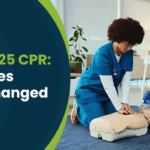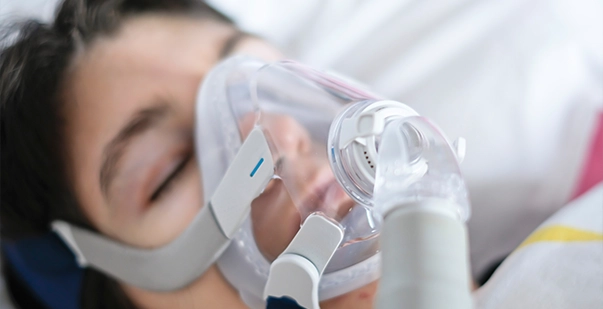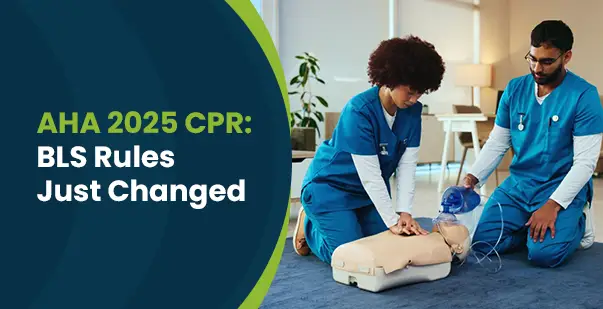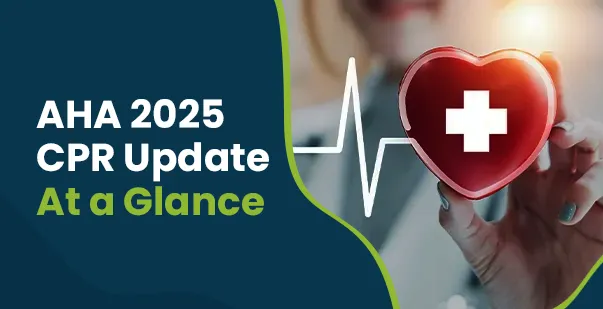If you suffer from sleep apnea or any other sleep disorder, the condition can restrict your ability to breathe properly, making it difficult to get a good night’s sleep. According to a recent report, over 39 million adults in the U.S. have obstructive sleep apnea. Over the years, medical research has evolved, introducing AED courses and therapies to address the issue.
Although there isn’t a permanent cure for these conditions, there are methods you can use to manage the symptoms. A BiPAP machine (Bilevel Positive Airway Pressure Device) is one such device, typically a desktop ventilation system designed for better respiratory care.
The device delivers air into the lungs through a mask worn over the face. You might be wondering what exactly the machine does. It helps people with sleep apnea breathe more effectively and effortlessly during sleep. Keep reading to learn more about its functionalities, the science behind it, and its benefits and side effects.
What is a BiPAP Machine?
BiPAP machine is non-invasive medical equipment used to treat sleep apnea. It delivers pressurized air into your lungs through a mask. It is used when individuals can breathe on their own but cannot get adequate oxygen or exhale carbon dioxide. The device can provide different air pressure levels, including EPAP (Expiratory Positive Airway Pressure) and IPAP (Inspiratory Positive Airway Pressure), to make breathing easier. The machine is generally used at home or in hospitals to help people breathe better when they have difficulty breathing.
How Does BiPAP Machines Work?
BiPAP machines operate to improve the breathing experience for individuals who struggle with sleep and respiratory disorders. To understand BiPAP settings and their mechanisms, it’s important to explore their key components and specific functions.
- Airflow Generator: This unit contains a motor that generates and regulates the dual pressure of air delivered to the patient.
- Mask: The mask, which comes in different styles and sizes, is worn over the nose, mouth, or both and serves as the conduit to deliver pressurized air to the user.
- Tubing: This connects the airflow generator to the mask and channels the air from the system to the patient.
Master First Aid Skills
First Aid Certification course that prepares you for real-life situations.
Uses of BiPAP machine
BiPAP machines are specifically designed to assist individuals with breathing difficulties, providing personalized air pressure support during inhalation and exhalation. The device is primarily used for the following purposes:
Sleep Apnea Treatment
BiPAP machines are primarily useful for individuals suffering from Obstructive Sleep Apnea (OSA) or other sleep-related breathing disorders. These machines drive pressurized air into your lungs to help you maintain ideal airflow, ensuring continuous breathing during sleep, reducing snoring, and improving sleep quality.
Respiratory Support for Lung Conditions
BiPAP machines also play a vital role in treating various respiratory conditions, such as COPD (Chronic Obstructive Pulmonary Disease), pneumonia, or neuromuscular disorders. These devices promote respiratory function by delivering adequate air pressure support during both exhalation and inhalation. They make it easier for patients to receive sufficient air and oxygen when they are having difficulty breathing.
Read More: Asthma First Aid: What To Do During An Asthma Attack?
Benefits of BiPAP Machine
The BiPAP machine is a game-changer in respiratory medicine, generating a flow of air at two different pressures to facilitate an effortless breathing pattern during sleep. Here are some key benefits of using a BiPAP machine:
Effective Treatment for a Wide Range of Sleep Disorders
Individuals with Obstructive Sleep Apnea, Central Sleep Apnea, or any other related disorders can opt for BiPAP therapy as an effective treatment. The device consistently maintains open airways, inducing easy breathing to manage these conditions.
Better Comfort and Adaptability
BiPAP machines have bilevel pressure settings that allow for individualized treatment, accommodating patients with varied pressure needs. The higher pressure during inhalation aids in the complete intake of air, while the lower exhalation pressure reduces the feeling of force or difficulty in exhaling. This adaptability leads to enhanced comfort and a more peaceful sleeping experience for patients.
Reduce the Risk Associated Health Conditions
Inadequate or disrupted sleep can contribute to a wide range of health problems, including hypertension, heart attack, strokes, and diabetes. By effectively treating sleep disorders with a BiPAP machine, you can reduce the chances of developing these associated health conditions.
Eliminate the Pressure-Related Discomfort
The availability of two distinct pressures for inhalation and exhalation allows BiPAP machines to significantly reduce pressure-related discomfort. Unlike CPAP, where some individuals find it hard to exhale against a single, constant pressure, the technology of BiPAP offers reduced pressure during exhalation.
Difference Between BiPAP and CPAP
Both CPAP and BiPAP are systems used in the treatment of obstructive sleep apnea. CPAP (Continuous Positive Airway Pressure) provides a continuous flow of air at a single pressure to keep the airway open and prevent respiratory interruption.
BiPAP, on the other hand, is designed for people who face challenges exhaling against the pressure of a CPAP machine. Both are effective treatments for sleep-related breathing disorders. When analyzinganalysing the difference between CPAP and BiPAP, it’s important to consult with your healthcare provider to make an informed decision that improves your respiratory health and well-being.
Here’s an overview of BiPAP Vs CPAP.
| Parameters | BiPAP | CPAP |
| Air Pressure | Variable or two levels (higher for inhalation, lower for exhalation) | Constant or single-level |
| Breathing Pattern | Bilevel (inhale and exhale) | Continuous |
| Indication | Sleep apnea with difficulty in exhaling and diagnosed with neuromuscular disorders | Obstructive sleep apnea and snoring problems |
| Comfort | More comfortable, especially for treating exhaling problems | Might cause discomfort due to fixed pressure |
| Adjustment | Greater flexibility in altering the pressure levels | Limited adjustment options |
| Settings | Dual pressure settings – Inspiratory and Expiratory Positive Airway Pressure | A single constant, pressure setting. Includes a ramp feature to steadily increase pressure, easing the patient to sleep. |
| Advantages | Prepare for special codntions like hypoventilation syndrome and neuromuscular diseases that demand more breathing support. | Reduce the risk of health problems associated with untreated sleep apnea such as heart problems, stroke and high blood pressure. |
Read More: Cardiac Arrest: Risk Factors, Symptoms, a Treatment
Which One is Better – CPAP Vs BiPAP?
When it comes to CPAP Vs BiPAP, healthcare professionals typically recommend CPAP for obstructive sleep apnea, while BiPAP is used for central sleep apnea. However, there are certain conditions where BiPAP is preferred over CPAP:
- Central Sleep Apnea: If you have central sleep apnea, you may struggle to regulate your breathing while sleeping. In severe cases, medical professionals recommend BiPAP over CPAP.
- Complex Sleep Apnea: Similar to central sleep apnea, people with complex sleep apnea often respond better to BiPAP machines, while CPAP may be ineffective.
- Obesity Hypoventilation Syndrome: This form of sleep-disordered breathing is common in obese individuals, causing them to breathe too shallowly or slowly during sleep. These changes can lead to respiratory depression, resulting in low oxygen and high carbon dioxide levels in the bloodstream. If left untreated, it can cause heart or respiratory failure. BiPAP is considered more effective than CPAP for this condition.
- COPD/Overlap Syndrome: Overlap syndrome refers to having both sleep apnea and COPD (Chronic Obstructive Pulmonary Disease). This condition can prevent the body from balancing oxygen and carbon dioxide levels in the bloodstream, leading to severe health complications that can be effectively managed with a BiPAP machine.
Side Effects of BiPAP Machine
The BiPAP machine is generally a safe alternative to CPAP devices, but there are a few things to consider before making your choice. Here are some common side effects of using the device:
- General Discomfort – Wearing a BiPAP mask can cause discomfort when trying to sleep. The mask might feel constraining, and the hose can interfere with certain sleeping positions, particularly if you don’t sleep on your back. If the machine’s pressure is too high, it may cause exhaustion.
- Claustrophobia – Some individuals may feel claustrophobic while wearing the BiPAP mask, which is designed to fit snugly around the nose and mouth.
- Dry Mouth – Dry mouth is a common side effect, especially for those using full-face masks or nasal masks while breathing through their mouths.
- Sinus Congestion: Dryness or stuffiness in the nose is another potential side effect of BiPAP therapy, as the constant airflow from the machine can sometimes cause nosebleeds.
- Skin Irritation: If the mask is too tight, it can cause redness and irritation. To alleviate these symptoms, you can loosen the mask, use mask liners, or try a different mask style or size.
- Mask Leakage: If the mask is too loose, it may start leaking air, which can affect the machine’s ability to provide the prescribed pressure and disrupt your breathing pattern. Ensure the mask is properly fitted and sealed to your face.
- Bloating: Bloating can occur when you inhale excess air, leading to a bloated stomach, abdominal pain, nausea, and vomiting.
First Aid Training Made Easy
Learn essential first aid care from anywhere with our online course
Get Better Respiratory Care with BiPAP Machine
BiPAP machines are not just an effective strategy for managing various sleep disorders; they also enhance sleep comfort, enabling a more peaceful sleep experience. Their unique dual pressure delivery system makes them an effective option for providing optimal support and comfort during sleep. The various modes available on the device allow you to customize the settings to suit your specific needs and preferences. With the right guidance, you can use a BiPAP machine to give your lungs a rest at night, leading to better-rested sleep and improved energy levels.









